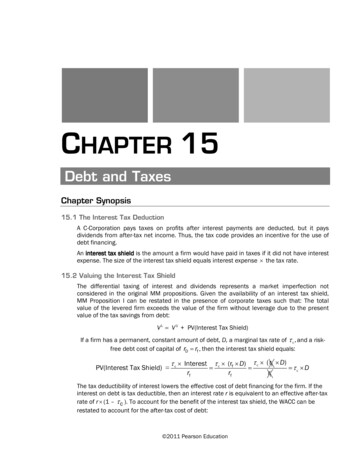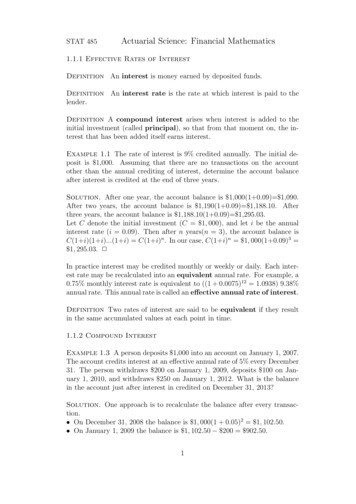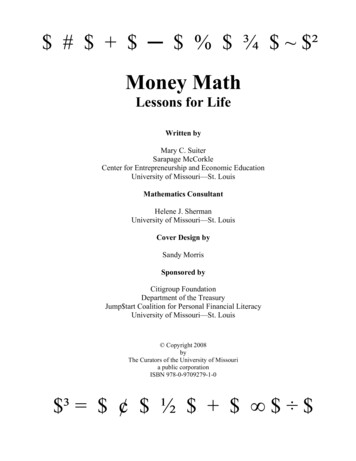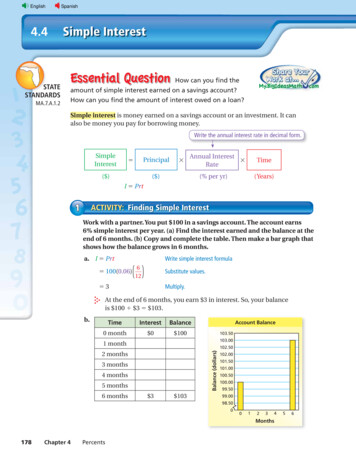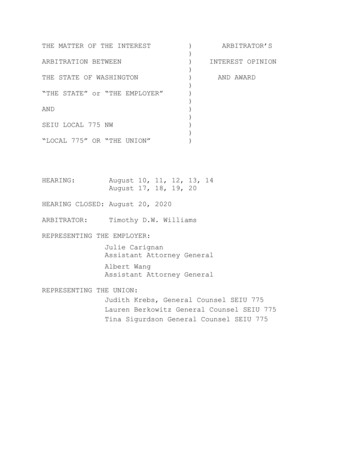
Transcription
THE MATTER OF THE INTERESTARBITRATION BETWEENTHE STATE OF WASHINGTON“THE STATE” or “THE EMPLOYER”ANDSEIU LOCAL 775 NW“LOCAL 775” OR “THE T OPINIONAND AWARDAugust 10, 11, 12, 13, 14August 17, 18, 19, 20HEARING CLOSED: August 20, 2020ARBITRATOR:Timothy D.W. WilliamsREPRESENTING THE EMPLOYER:Julie CarignanAssistant Attorney GeneralAlbert WangAssistant Attorney GeneralREPRESENTING THE UNION:Judith Krebs, General Counsel SEIU 775Lauren Berkowitz General Counsel SEIU 775Tina Sigurdson General Counsel SEIU 775
APPEARING AS WITNESSES FOR THE STATE:DAY 1Bill Moss, DSHS Assistant Secretary Aging andLong-Term Support AdministrationLeo J Kapust, DSHS IPOne Operations ManagerDay 6Nona Snell, Assistant Director for Budget OFMEric Mandt, Assistant Director ManagementServices ALTSADennis Elonka, Jr, DSHS Contract ProjectManagement ConsultantDay 7Rina Wikantari, Budget Forecaster DSHSChristi Pederson, DSHS Long Term SupportAdministrationDay 8Ann Green, OFM Human Resources Division – LaborManagement SectionDay 9Closing Arguments by Albert WangAPPEARING AS WITNESSES FOR THE UNION:Day 1Allyson Fredericksen, Operations and FinanceManager Washington Low Income Housing AllianceDesirae Hernandez, Individual Provider and AgencyProviderDay 2Marcus Morrell, Di Martino and AssociatesLaura Reding, Managing Director – Health BenefitsTrustLaura Zaichkin, HBT Director of Health PlanPerformanceBrittany Williams, Individual ProviderHomecare Workers Interest Arbitration for 2021-2023 CBA: DSHS/SEIU Local 775 NW, pg. 2
Steven Hill, Retired Director Washington HealthCare AuthorityJonathan Seib, Principal Seib Policy and PublicAffairsDay 3Adam Glickman, Secretary/Treasurer SEIU 775Darryl Johnson, Individual ProviderDanielle Rice, Individual ProviderDay 4Peter Nazzal, Director Catholic CommunityServicesAdam Glickman, Secretary/Treasurer SEIU 775Regina Denton, Individual ProviderBea Rector, Home and Community Services DirectorLinda Lee, Individual ProviderDay 5Andrew Nicholas, Senior Fellow Washington StateBudget and Policy CenterNidhi Mirani, Executive Director CarinaDay 6Sterling Harders, President SEIU 775Day 8Adam Glickman, Secretary/Treasurer SEIU 775 –rebuttal witnessDay 9Closing Arguments by Judy KrebsHomecare Workers Interest Arbitration for 2021-2023 CBA: DSHS/SEIU Local 775 NW, pg. 3
EXHIBITSJOINT12004 Interest Arbitration Award22006 Interest Arbitration Award32008 Interest Arbitration Award42009 Interest Arbitration Award52010 Interest Arbitration Award62012 Interest Arbitration Award72019-2021 CBA, The State of Washington and SEIUHealthcare 775NW82017 – 2019 CBA, The State of Washington and SEIU 77592015-2017 CBA, The State of Washington and SEIUHealthcare 775NW102013-2015 CBA, The State of Washington and SEIUHealthcare 775NW112011-2013 CBA, The State of Washington and SEIUHealthcare 775NW1208/07/2020 PERC Certification of Issues13RCW 74.39A14RCW 41.56.02615RCW 41.56.46516Appendix A Wage Scales – State Proposal16a Appendix A Wage Scales – State Proposal with trackedchanges179 – Comprehensive Health Care Benefits – State Proposal17a Article 9 – Comprehensive Health Care Benefits – StateProposal with tracked changes18Appendix A Wage Scales – Union Proposal19Article 8 – Compensation – Union Proposal20Article 9 – Comprehensive Health Care Benefits – UnionProposal21Article 14 – Referral Registry Final – Union Proposal22New Article – Holidays – Union ProposalSTATE1State of Washington Office of Financial Management “The2021-2023 Budget Story”, dated June 20202State of Washington Office of Financial Management BudgetSavings and Reductions Memo, dated April 14, 20203Department of Social and Health Services (DSHS) Aging andLong Term Support Administration (ALTSA) OrganizationalChart, dated July 20204DSHS/Developmental Disabilities AdministrationOrganizational Chart5DSHS IP Interest Arbitration Powerpoint PresentationHomecare Workers Interest Arbitration for 2021-2023 CBA: DSHS/SEIU Local 775 NW, pg. 4
30Office of Financial Management “A Guide to the WashingtonState Budget Process”Navigating DSHSALTSA - Becoming a Paid CaregiverWhich Mask for Which Task?Draft CFC DDA June 2020 Forecast SpreadsheetDraft LTC June 2020 Forecast Spreadsheet2021-2023 Comps. Spreadsheet2021-2023 Updated Comps. SpreadsheetHoliday Comps.2019-2021 SEIU Healthcare Minnesota and the State ofMinnesota CBA2016-2021 PCA Workforce Council and New England Health CareEmployees Union, District 1199, SEIU CBA2019-2021 Oregon Home Care Commission and SEIU Local 503,Oregon Public Employees Union CBA2020 ALTSA-DDA Medicaid Forecasts SpreadsheetsWA LTSS Workforce Individual Provider 2019-2021 PowerPointPresentationIndividual Provider One Interface DiagramSEIU Interest Arbitration Long-Term Services & SupportsIndividual Providers PowerPoint PresentationAging and Long-Term Support Administration FY2020Preliminary Budget Reduction Proposal Q & AIn-Home CBA Bien2021-2023 – State Proposal ArbitrationIn-Home CBA Bien2021-2023 – Union Proposal ArbitrationIn-Home CBA Bien 2021-2023 – Union Proposal ArbitrationAmendedWithdrawnDSHS Budget Savings Options 2020Health Benefits Trust FY 22-23 Bargaining PresentationRina Wikandari ALTSA Costing PowerPoint PresentationCOVID MOU TA3 signed both partiesCOVID MOU July-SeptemberState’s Closing Argument PowerPoint PresentationUNION1Job Gap 20202Comparison of Proposals and Projected Living Wages3Members with Dependent Children4Seattle Times Child Care Costs5State Projected Wage Modeling6Hernandez, Desirae Budget7KPWA Medical Trend Letter8AON/SIGEL Medical Trend Projections9Actual Trend On Eligibility Growth10FMLA-2012-Executive-SummaryHomecare Workers Interest Arbitration for 2021-2023 CBA: DSHS/SEIU Local 775 NW, pg. 5
363738394041424344454647Baseline Cost ModelImpasse Article Health Costing ChartStatus of Collectively Bargained Benefits – MillimanResearch ReportHBT Board of Trustees roster and participating employersCaregiver demographicsKPWA prevalence of chronic conditions – HBT vs KPWA book ofbusinessHBT medical and dental carriers and HBT medical and dentalplan summariesCaregiver safety benefitColorectal cancer screening programGinger virtual behavioral health benefitACESBarlow Memo CDE ImpactDependent Coverage Strategy – Adopted 11.2019Dependent Dental BenefitWilliams, Brittany BudgetApril 22, 2019 Finance and Investment SubcommitteepresentationSEIU Dependent Coverage Report Resources FinalEmployee Benefits 2019 Healthcare and Health ServicesThe Most Desirable Employee BenefitsDeterminants of Longer Job Tenure Among Home Care AidsWashington Home Care Market AssessmentBuilding the Workforce We Need for People with SeriousIllnessDemand for Home Care Expected to BoomSomething’s Rotten: Oral Health Care Access in the UnitedStatesALTSA LTSS Rebalancing SavingsCurrent Home Care Wages Vs Living WageMonthly Average HoursCurrent Caregivers in Poverty ChartComparison of Hourly Entry Level Wages in Washington w.CitationsFirst Pass Appendix A Wage Scales 2020 06 23 FinalInflation Indicators Forecast 2021 – 2015Union vs. State’s Proposals on Inflation Adjusted StartingWageFuture Home Care Wages Vs Living WageUnion vs. State Wage Proposals compared to Seattle MinimumWage2% Increase Wage ProposalBargaining History on Wage StepsNumber of Ips at Top TierHomecare Workers Interest Arbitration for 2021-2023 CBA: DSHS/SEIU Local 775 NW, pg. 6
73747576777879808182838485868788899091Union vs. State Wage Proposals Compared to Illinois BaseWageUnion vs. State Wage Proposals Compared to San FranciscoBase WageSeattle Minimum Wage Multi Year Chart2008-2012 Impact of No or Small RaisesCost of Living ComparisonDSHS CDE ContractComp Chart on CCH ReciprocityGas Prices 2015-2020History of Mileage CapHCS RatesNurse Delegation Paid Differential Comparable AgenciesGrowth of Carina ServicePrevalence of Paid Holidays by Worker CategoryPaid Holidays for Ips in other States & Comparable Agenciesin WAHCII & State of Illinois 2019-23 ContractCDE Labor Rate & Admin Rate ComponentsJohnson, Darryl BudgetJohnson, Darryl AP CCHDenton, ReGina BudgetCBPP: Budget Cuts vs. Tax IncreasesLetter from economic & policy experts to WA leadershipEPI Analysis MN & WIWA BPC Home Care Workforce Wage StudyJune Economic and Revenue ForecastDOR market value of all real estate in WATop wealth holders in WA by asset typeDOR revenue alternativesKing County Executive press releaseFiscal note for SB 6017Seattle fiscal noteCarbon tax fiscal noteDOR tax actionsSen. Jamie Pederson Q ACase for repealing the state’s balanced budget law2020 Debt Limit Letter from the TreasurerCarina PresentationWA HCQA Feasibility Report-FinalIP to Jobs Supply May Carina 8.13.2020Washington’s Population is AgingIncreasing home care demand2017 AARP LTSS scorecardNH cost comparisonWA Essential Critical Infrastructure WorkersPoverty wages for Ips racial inequityHomecare Workers Interest Arbitration for 2021-2023 CBA: DSHS/SEIU Local 775 NW, pg. 7
11112113114115116117118SOBW Report 2017At the Wage Floor, Thomason, UC Berkeley Labor Center,May 2018HCA PEBB information responseWFSE 2019-2021 CBAJuly 2020 Economic and Revenue UpdateKing5 – Budget Cuts New Taxes Washington Weighs bothState Information response nurse delegationSEIU Information Response Nurse delegated clientsCFC eligibility WACOFM food service worker classificationOFM NA classificationState response IPs with legacy advance trainingAgency Vendor RateLegislative Meetings ChartHospital safety net assessment fiscal noteHospital safety net bill reportManatt Home care provider tax presentationWage inflation chart v 2% stateCompression ChartHealth care summary chartsPPL MA TimesheetAP CCH Cost SavingMedical Trend EmailCaregivers have kidsContinuous coverage extended to caregivers whose hours havebeen impacted by COVIDUnion Closing Argument 2020Motion for Judicial Notice of State's Economic & RevenueUpdateBACKGROUNDThe Service Employees International Union, Healthcare 775NWrepresent a bargaining unit composed of individual health careproviders (IPs) under RCW 74.39A.270.The State of Washington(hereafter “the Employer” or “the State”) and the Service EmployeesInternational Union Healthcare 775NW (hereafter “the Union”) arein the process of negotiating a successor collective bargainingHomecare Workers Interest Arbitration for 2021-2023 CBA: DSHS/SEIU Local 775 NW, pg. 8
agreement (CBA) for the 2022-2023 biennium (July 1, 2021 throughJune 30, 2023).Unable to reach agreement on a number of issues,the parties decided to submit the matter to interest arbitrationas is provided by statute.RCW 41.56.450 provides that if “an agreement has not sandmediation, and the executive director, upon the recommendation ofthe assigned mediator, finds that the parties remain at impasse,then an interest arbitration panel shall be created to resolve thedispute.The issues for determination by the arbitration dbytheexecutiveBy letter dated August 7, 2020 PERC Executive DirectorMichael Sellers certified the following issues to arbitration:The Employer has submitted the following issues for certification: Appendix A – Wage ScalesArticle 9 – Comprehensive Health Care BenefitsThe Union has submitted the following issues forcertification: Appendix A – Wage ScalesArticle 2 – Union RightsArticle 4 – Membership Dues and Other DeductionsArticle 5 – Bargaining Unit InformationArticle 7 – Grievance and Dispute ResolutionArticle 8 – CompensationArticle 9 – Comprehensive Health Care BenefitsArticle 1 – Paid Time OffArticle 12 – PayrollArticle 13 – No DiscriminationArticle 14 – Referral RegistryHomecare Workers Interest Arbitration for 2021-2023 CBA: DSHS/SEIU Local 775 NW, pg. 9
rticleArticleArticleArticleArticle15 – Training19 – Policies, Programs and Practices20 – Hours of Work21 – Retirement Benefits25 – Term of Agreement26 – Contracts and Overpayments27 – Health and Safety28 – SuccessorshipW – HolidaysX – HAD ItY – Electronic Visit VerificationZ – ArbitrationWashington Administrative Code (WAC) 391-55-205 permits theParties to waive the requirement for partisan arbitrators and toselect a neutral Arbitrator.The Parties selected Timothy D.W.Williams as neutral Arbitrator.ArbitratorWilliamsoveraA virtual hearing was held beforeperiodofninedaysontheZoomplatform.At the outset of the hearing the Union informed the Arbitratorthat most of the issues certified for arbitration were no presentedtotheAs to what was presented, both the State and the Unionprovided evidence and arguments on Wage Scales and ComprehensiveHealthcare Benefits.Additionally, the Union proposed changes toArticle 8, Compensation; Article 14, Referral Registry; and a newArticle on Holidays.At the hearing, both Parties had full opportunity to makeopening statements, examine and cross-examine sworn witnesses,Homecare Workers Interest Arbitration for 2021-2023 CBA: DSHS/SEIU Local 775 NW, pg. 10
present documentary evidence, and make arguments in support oftheir positions.RCW 41.56.450 provides that “a recording of theproceedings shall be taken.”In compliance with the statute, anofficial transcript of the proceedings was taken, and a copy wasprovided to the Arbitrator.At the close of the evidentiaryhearing, the Parties were given the opportunity to do closing oralarguments which were presented during the morning of August 20,2020.In accordance with WAC 391-55-240, the Arbitrator declaredthe hearing closed on August 20, 2020.This document contains hisfinal analysis, conclusions and the interest award.ARBITRATOR’S AUTHORITYAn arbitrator’s authority to issue an interest award isgenerally derived from “theRCW 74.39A.270 provides, itrationand41.56.480RCW 41.56.465(5) requires that the arbitrator, in makinghis or her decision, consider the following criteria:(a)The panel shall consider:(i)A comparison of wages, hours, and conditions ofemployment of publicly reimbursed personnel providing similarservices to similar clients, including clients who areelderly, frail or have developmental disabilities, both inthe state and across the United States(ii) The financial ability of the state to pay for thecompensation and fringe benefit provisions of a collectivebargaining agreement; and(b)The panel may consider:Homecare Workers Interest Arbitration for 2021-2023 CBA: DSHS/SEIU Local 775 NW, pg. 11
(i)A comparison of wages, hours, and conditions ofemployment of publicly reimbursed personnel providing similarservices to similar clients, including clients who areelderly, frail or have developmental disabilities, both inthe state and across the United States.(ii) The state’s interest in promoting a stable long-termcare workforce to provide quality and reliable care tovulnerable elderly and disabled recipients;(iii) The state’s interest in ensuring access to affordable,quality health care for all state citizens; and(iv) The state’s fiscal interest in reducing reliance uponpublic benefit programs including but not limited to medicalcoupons, food stamps, subsidized housing and emergencymedical services.(6)Subsection (2) and (3) of this section may not beconstrued to authorize the panel to require the employer ributions resulting from chapter 502, Laws of 1993 orchapter 517 Laws of 1993 as required under chapter 41.26 arefully weighing the above factors when rendering his ly applied the above criteria.theArbitratorhasAdditionally, he has beencareful to give special consideration to those criteria that werethe focal points of the discussion between the two heconclusion of the hearing to make “written findings of fact and awritten determination of the issues in dispute.” The instant case,however, is different in that the parties, at the time that theyretained his services, requested the award by September 25 andthat the award would fail to meet the legal timeline if it was notdelivered by October 1, 2020.The Arbitrator has worked to complyHomecare Workers Interest Arbitration for 2021-2023 CBA: DSHS/SEIU Local 775 NW, pg. 12
with that understanding and has focused his efforts on writing anaward that sets forth the key points in his determinations.In summary, the final decision is provided issue by issue andis based on a thorough review of the documentary and testimonialevidence that has been provided, a careful study of the closingarguments and the faithful application of the statutory criteria.The decision continues with an overview followed by the award,issue by issue.OVERVIEWClearly, the best place to begin this overview is to recognizethe accomplishments of the Parties with regard to their mutualefforts to improve the quality of home healthcare.Bill Moss,testifying on behalf of the State, emphasized this fact when hestated:We have, in the Aging and Long-Term Support Administrationbeen a national leader in the delivery of long-term servicesand support home and community-based services for more thana couple of decades. The most recent AARP poll, as you heardJulie say earlier, we were ranked No. 1.The prior threeyears before that we were ranked No. 2 behind Minnesota, butwe have always been, I would say, within the top five in termsof how we do services and those kinds of things. (Tr 53)There are two things clear to this Arbitrator about the No.1 ranking. The first, amply supported by testimony from both Stateand Union witnesses, is that the parties have worked cooperativelyon building many aspects of the nation leading home and communitybased services.There is a shared vision on what they areHomecare Workers Interest Arbitration for 2021-2023 CBA: DSHS/SEIU Local 775 NW, pg. 13
attempting to accomplish.Mr. Moss’ testimony strongly emphasizesthis fact when he states:I think SEIU 775 has contributed a great deal to the successof Washington and being able to serve seniors and individualswith disabilities .So I just want to -- even though we’re here at arbitrationtalking about money, I just wanted to highlight that we havea lot -- we have many common goals and a lot of alignment interms of where we want to see the long-term care system inWashington go. (Tr 53, 54)The second point is that the high ranking is a reflection ofa substantial investment of public dollars into the programs.Inits opening statement, the State emphasizes the fact that in nvestment “by over 150 million per contract.itsAs the Unionacknowledged, over the last three contracts, IPs wages have goneup, and IPs enjoy benefits such as paid time off, health care andretirement benefits and training opportunities” (Tr oredollarsinvested are 262 million in 2015-17, 168 million in 2017-19 and 164 million in 2019-212 (Tr 63).Not surprising, this interest arbitration is all about money.Every issue in dispute has a attached to it.The State isEach bargaining cycle is for a two-year biennium beginning July 1 of an oddyear and ending June 30 two years later. The instant negotiations are forthe biennium commencing July 1, 2021 and ending June 30, 2023.2 A review of the transcript clearly indicates that two different figure’ssurface. One set of figures provide the complete cost of wage and benefitincreases. As a Medicaid driven program, these complete costs were paid forby both State and Federal dollars. There is a second set of cost figuresthat are just the State’s portion of the increased costs.1Homecare Workers Interest Arbitration for 2021-2023 CBA: DSHS/SEIU Local 775 NW, pg. 14
proposing increases in two areas, wages and insurance.Costingfigures provided through testimony and exhibits indicate thattotal new State dollars is 25 million; a very thin offer comparedto the last three bargaining cycles for reasons that will bediscussed later.The Union also puts forward a request for increases to thesalary schedule and the insurance payment; a request substantiallygreater than that offered by the State.Additionally, it proposesto change a number of provisions in the contract, including addinga new Article granting holiday pay, all of which require additionalmoney. Total new State money associated with the Union’s proposalsare in the 130 million range (Tr 520, 883, 1178).The Union’sproposal, therefore, is roughly equivalent to the amount of Statedollars that were added in each of the last three bargainingcycles.The Arbitrator notes that the discussion during the interestarbitration hearing around wages and benefits clearly reflectedthe unique nature of this bargaining unit.Washington, like manystates, provides interest arbitration in lieu of the right tostrike for employees in essential services like police and fire.Typically, the discussion for those bargaining units over wagesand benefits focuses on increases to the cost of living andcomparable wages.While both of those factors were a matter ofdiscussion in the instant arbitration hearing, the dominant focusHomecare Workers Interest Arbitration for 2021-2023 CBA: DSHS/SEIU Local 775 NW, pg. 15
was on the relationship between improved wages and benefits as thedetermining factor in making home healthcare a profession thatpeople can aspire to.The Union strongly built its case aroundwhat it called the historical pattern of discrimination related towages and benefits paid to women and Since homeminoritiesthisclearly denoted pattern of discrimination has worked to keep wagesquite low.The Union emphasized that even with the lastthreebargaining cycles, most of the employees in the bargaining unitstill fail to make a living wage.Significantly integrated into the discussion around creatinga profession that a person can aspire to was the recognition thathome healthcare is a rapidly expanding area of employment (Tr 742).Morethanjustanareaofjobgrowth,significant employment vacuum for the State.itispotentiallyaThe term used duringthe hearing was “silver tsunami” (Tr 955, 1019).The Arbitratornotes that the significance of the term silver tsunami is welldocumented in the testimony of Union president Sterling Harders:And so you can see in this chart [Un. Ex 86] that by 2040,the State is forecasting that we’ll have an elderly populationof just about 2 million.And you can also see that thepopulation of folks over 85 will nearly triple to almost400,000 by 2040. So this just demonstrates the rate at whichthe population of Washington State is aging. (Tr 741)Homecare Workers Interest Arbitration for 2021-2023 CBA: DSHS/SEIU Local 775 NW, pg. 16
icant increase in the older population will result in dthroughout the testimony of both State and Union witnesses (Tr316, 611, 1019).Testifying on behalf of the State, Bea Rectorprovided the following exchange on cross examination:Q.So if the State is generally concerned about anoverall shortage of home care workers and – andcompetition between Medicaid clients and private-payclients, isn't the real solution to that to figure outhow to recruit more home care workers?A.Yes, and we are doing that. We have workforceinitiatives that we -- we are working on aroundrecruitment and retention, and we have contracts inplace with our home care referral registries that theyrecruit a certain number of new individual providerson a monthly basis, and that same expectation is goinginto the Consumer Directed Employer contract.The Arbitrator emphasizes that State witnesses clearly showedan understanding of how the new labor agreement would impact theability to recruit a significant number of new individual providers(IPs) (Tr 955).Ann Green was the chief negotiator for the Stateduring the negotiations that led ultimately to this interestarbitration process.She testified as follows:And so taking into consideration the limited dollars thatwe had, and I think what we've already heard in testimony,the age wave or the, I think what someone referred to as asilver tsunami, that we needed to continue to recruit andattract IPs into the workforce. We put the limited dollarsthat we had and we focused the increase in the first stepto make that attractive or to continue to make itattractive to new IPs and to be mindful of minimum wage.(Tr 1019, 1020)Homecare Workers Interest Arbitration for 2021-2023 CBA: DSHS/SEIU Local 775 NW, pg. 17
The Arbitrator further notes that the focus during the withrecruitment and retention were two of several significant issuesdiscussed.There were the additional issues created by the changeof employer that will occur during the term of the new laboragreement.By statute, the State of Washington will no longer bethe employer for this bargaining unit. Dennis Elonka Jr, testified(Tr 844-45) that he was the State’s project manager to oversee theprocess by which a transition was made from State employment toprivate employment (Consumer-Directed Employer) for the SEIU 775bargaining unit.He further stated:So Consumer-Directed Employer is what’s called out by statestatute.Consumer Direct of Washington is the vender whowill be operating as the Consumer-Directed Employer. We referto them as CDWA. (Tr 847)From the testimonial evidence, it is clear that both Partiesrecognize that this change is significant with regard to the newcontract.There is no question that the new Employer is requiredto assume the 2021-23 agreement.betweenalaborcontractThere is a difference, however,administeredadministered by a private employer.bytheStateandoneMs. Green, the State’s chiefnegotiator, succinctly testified about the impact of the change:Q.Besides the budget, were there any other major issueskind of different about this particular bargainingsession?A.Yes. The consumer-directed Employer and the timelineof that transition. We -- in the previous session, inHomecare Workers Interest Arbitration for 2021-2023 CBA: DSHS/SEIU Local 775 NW, pg. 18
2018, we knew that the CDE was likely to come. Therehad been a delay. And so probably a year ago at thistime we all -- everyone in this room, aside from maybethe arbitrator and the court reporter, were not – wewere assuming we weren't going to bargain this summer.And then that changed, and we needed to bargainanother contract, given the timeline of thattransition.So that transition is going to happen, as we've heardin testimony, July 1st, likely conclude on November -July 1st of 2021. It will conclude on November 1st of2021. And that transition played a huge role in howwe looked at the contract and the things that we coulddo, the major changes or the payroll changes of thevarious interfaces that are as a result of things thatwe collectively bargained.From a State perspective, we were looking for a verysmooth transition to the – we are looking for a verysmooth transition to the CDE. In my tenure, I've neverseen a situation where we've essentially privatized40-plus thousand individuals in our workforce. And soa transition of that nature, I think, is historic andundoubtedly will be very complicated. And so ourdesire was to ensure that whatever we did from thecollective bargaining resulted in a smooth, calm, andorderly transition. And that really equated to thenperhaps we don't do any new things, any new thingssuch as holidays or differentials or things that wehad never done before that cause payroll changes orthings that we have to do to program the system whichwill then be going away four months after it isimplemented. So it was a deliberate effort tominimize changes and to really focus on what we felt,in the pandemic, what's most important to appease andI think to everybody is wages and benefits. And thatwas the sort of focusing of our bargaining and wherewe really wanted to make changes and make adifference. (Tr 1016, ltransition is set to commence with a small group beginning July 1of 2021 and ultimately to be completed in the next few months.One of the factors that makes this a significant issue is that theHomecare Workers Interest Arbitration for 2021-2023 CBA: DSHS/SEIU Local 775 NW, pg. 19
computer software currently used by the State to manage more than40,000 employees will be changed to an entirely new softwareprogram.The State is understandably resistant to implementchanges in the current system that will cost significant dollarsand have a lifespan of less than half year.While the Union issomewhat sympathetic to this issue, it does not believe that muchneeded changes should be held hostage to the transition.Beyond the above points of discussion, there is anotherextremely significant issue impacting theseelephant in the room.negotiations,theThe Arbitrator must consider “the financialability of the State to pay for the compensation and fringebenefits provisions ”COVID has had a significant and negativeimpact on the State’s projected ability to pay the cost of wagesand benefits provided to this bargaining outrelatedwhattobargaining agreement is the uncertainty.round of COVID?amakesthesuccessorcurrentcollectiveWill there be a secondWill a second round, if it comes, have anadditional, negative impact on projected revenues?will the Washingtonstate economysuffered revenue losses because o
Homecare Workers Interest Arbitration for 2021-2023 CBA: DSHS/SEIU Local 775 NW, pg. 3 Steven Hill, Retired Director Washington Health Care Authority Jonathan Seib, Principal Seib Policy and Public Affairs Day 3 Adam Glickman, Secretary/Treasurer SEIU 775 Darryl Johnson, Individual Provider Danielle Rice, Individual Provider Day 4



